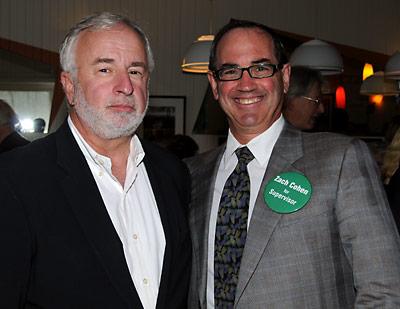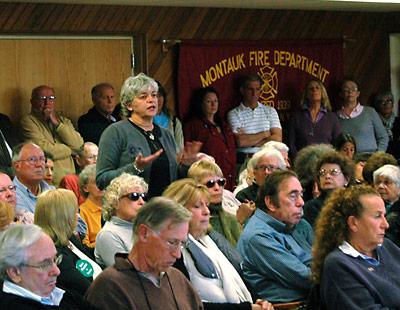Six in the Running for Two Seats
Six in the Running for Two Seats

East Hampton voters have a choice among six candidates for two town board seats when they go to the polls in a week and a half, thanks to the East Hampton Independence Party’s decision to field its own nominees for those spots rather than endorse larger party picks.
The Independence candidates, Bill Mott and Marilyn Behan, the Republican nominees Steven Gaines and Richard Haeg, and Democrats Sylvia Overby and Peter Van Scoyoc met with The East Hampton Star’s editorial staff on Oct. 13 to discuss their platforms, their plans, the state of the town, and a range of other subjects. An article last week offered insight into their top issues as well as their comments on the fishing industry, business, and the protections or shortcomings of the town code. This week, a sampling of their discussion about the role of the town board, their reasons for running, and the size of town government.
The Republican candidates had praise for how the current administration has worked to improve East Hampton’s finances, making tough decisions to tighten the town’s belt.
“We’re back from disaster, but we’re not out of the woods,” Mr. Haeg said. The belt-tightening “is not a fun thing to do. None of us are going to like it,” but it has been necessary, and because of it, he said, “this is the second year of holding the line with taxes.”
A question about the appropriate size of government and the depth of the public’s interest in tax cuts brought answers both practical and philosophical.
“We have 22,500 people living in this town, and when this administration started, we had a bigger government than some towns with 80,000 people,” Mr. Gaines said. Through early retirement, layoffs, and attrition, there are now 51 fewer town workers. “Of course it’s unpopular, but there was a $25 million deficit.” Supervisor Bill Wilkinson, a Republican, “was handed a dirty job,” he said. The community preservation fund “had been raided, bonds had been downgraded. One of the sad things was cutting some jobs.” Even so, he said, “We still have a pretty big governmental administration per capita.”
There is a “bit of an arrogance factor on the town board,” Mr. Mott said. The town is being “run like corporate America,” and not everyone likes that. “Yes, we have to cut the budget, but it’s not always the bottom line that matters.” Later, he added, “We’re all going to work on cutting the budget, that’s a given, but you also maintain the town.”
Ms. Overby said it is important to look at the value of the services government offers versus what it costs residents when they need to pay privately for services such as leaf pickup, which the town no longer offers. “We have a higher percentage of retirees, and we have to be conscious of them,” Ms. Overby said. In some cases, “the value of the service is better than the out-of-pocket expense. . . . A cost-benefit analysis doesn’t take a huge chunk of time or money.”
But Mr. Haeg said it is important to “prioritize the services we can give up, as opposed to the services we need as a community.” The town needs “the police, the lifeguards — there are other programs that we really need. The town board has done an excellent job in sorting things out and getting a sustainable working government,” he said.
“Most will agree that health and safety are what government should provide for the community,” Mr. Van Scoyoc said. Yet, he pointed out, the town cut fire marshal positions, meaning that “children in our schools are no longer able to get fire prevention instruction and education.” And with so much talk about year-round jobs, he said, “if you minimize government, you downsize jobs as well.”
Mr. Gaines said, “If we’re not in tremendous debt, then yes, we can look very carefully without raising taxes about some of the services we can put back or people we can rehire. But I’m not sure that’s the case right now.”
At the same time that services are being cut to save money, “we’re selling our assets at a loss,” Mr. Van Scoyoc said. He was critical of the town board’s decision to sell Fort Pond House in Montauk last year and its share in the Poxabogue Golf Center in Sagaponack, which it co-owns with Southampton Town, this year, both times without first holding a public hearing. He characterized both offerings as “short sales.”
“Maybe they were a bit hasty in their decisions,” Ms. Behan said, adding, “I do believe [Wilkinson] had a difficult job going into it. He had to do some difficult things. Do I like how he implemented them to the public? No. He was not informative enough. He kept things quiet and didn’t explain anything enough — that’s his biggest fault.”
Later, she added, “The town board has to realize we’re employees of the people. They pay us. . . . It’s imperative that they be heard.” Board members should take their concerns, research possible solutions, and “report back to the people who hired us.”
“The broadest possible discourse is really important,” Mr. Van Scoyoc said. “Do not discuss something like the airport without amplification,” he added, referring to a recent discussion of the airport that was held at the Montauk Firehouse. “That should have been in Town Hall, not Montauk.”
“The town board’s behavior toward people who come before it is asking what their qualifications are to get up and speak. You stand up because you’re concerned and you have something to say,” Ms. Overby said. She sees a reluctance on the part of the current administration to hold public hearings and take public opinion into account, and pointed as one example to the board’s decision to sell Fort Pond House. At public meetings “not one person I saw was in favor of that. I was surprised they didn’t listen.”
Ms. Overby also believes the town board has failed to involve the professionals in the Planning Department in decision making and has not looked for guidance to the professional planning studies that have been commissioned and adopted over the years. “The town board is making decisions without consulting these documents or these professionals,” she said.
The candidates, all of whom would be new to the town board, talked about how they would approach the job if elected.
Mr. Haeg, a former Suffolk County detective and private investigator and a decorated Vietnam War veteran, said, “my whole entire life I have been involved with the public and listened to them compassionately. . . . I intend to do that as a board member.”
Mr. Mott, who is completing his sixth term as a town trustee, said he has “a common-sense approach.”
Ms. Overby, who served on the town planning board for seven years, described herself as “passionate about my community, dedicated, and fair.” As a planning board member and chairwoman, she said she “always made sure the public and the applicants were heard. There were no time limits; we were very silent.”
“Fair, compassionate, and intelligent,” was how Ms. Behan said she hopes to be viewed. And, she said, she wants people to know “I’ll listen to them.”
“I’m an independent thinker and not part of anybody’s specific administration,” Mr. Gaines said. “I don’t have set feelings about the way things should be. . . . I speak what I think and feel.”
With Reporting by
Catherine Tandy





